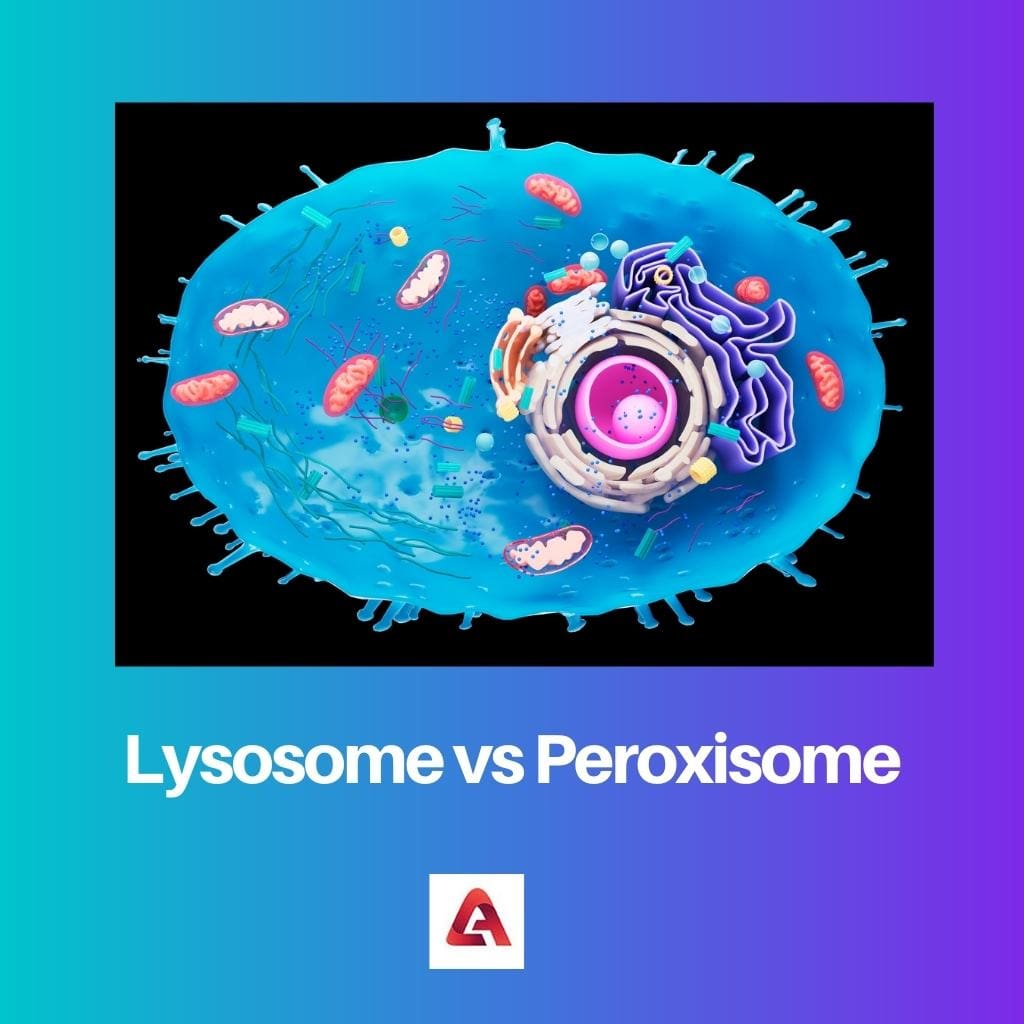One of the most common facts is that a cell is a key unit of life. Two kinds of single-membrane chambers are found within the cell: Lysosome and Peroxisome. While inside animals, only Lysosomes are found.
On the other hand, Peroxisome is there in every eukaryote cell. The size of lysosomes is quite large, whereas the peroxisomes are much smaller in size. Lysosomes and Peroxisomes are both chambers of an enzyme.
Key Takeaways
- Lysosomes are responsible for the breakdown of cellular waste and damaged organelles, while peroxisomes are responsible for the breakdown of fatty acids and other metabolites.
- Lysosomes contain hydrolytic enzymes and are involved in the degradation of proteins, nucleic acids, and carbohydrates, while peroxisomes contain oxidases and detoxify harmful substances.
- Lysosomes are formed by the Golgi apparatus and endoplasmic reticulum, while the division of pre-existing peroxisomes forms peroxisomes.
Lysosome vs Peroxisome
Lysosomes are membrane-bound organelles that contain enzymes responsible for breaking down and digesting cellular waste and foreign substances, such as bacteria and viruses. Peroxisomes are small, membrane-bound organelles that contain enzymes involved in various metabolic processes, including the breakdown of fatty acids.

The enzymes found in the peroxisome are responsible for carrying out the oxidation reactions and the breaking down process of hydrogen peroxide.
Comparison Table
| Parameter of Comparison | Lysosome | Peroxisome |
|---|---|---|
| Key function | Lysosomes’ main function is to ensure the breaking down of biological polymers, namely proteins and polysaccharides. | The main function of Peroxisomes is to ensure the oxidization of organic compounds and also to ensure the breaking down of metabolic hydrogen peroxide. |
| Composition | Lysosomes are made up of degradative enzymes. | Peroxisomes are made up of oxidative enzymes. |
| Responsible for | Lysosomes have the responsibility of ensuring the digestion process in a cell. | Peroxisomes have the responsibility of ensuring the protection of a cell from metabolic hydrogen peroxide. |
| Found in | Lysosomes are mainly present in animals. | Peroxisomes are mainly present in every eukaryote. |
| Derivation | Lysosomes originate from the Golgi apparatus or either from the endoplasmic reticulum. | Peroxisomes originate mainly from the endoplasmic reticulum and can replicate on their own. |
| Size | Lysosomes are big. | Peroxisomes are comparatively smaller in size. |
| Generation of Energy | Reactions being degradative do not generate any energy. | Reactions being oxidative, are capable of generating ATP energy. |
What is Lysosome?
A membrane-enclosed organelle found within a cell is known as a Lysosome. A lysosome comprises enzymes that can degrade biological polymers such as proteins, nucleic acids, lipids, etc.
The lysosome is shaped like a spherical vesicle, and it acts as a degradative system for both obsolete parts and biological polymers, which are found inside a cytoplasm.
Lysosomes are quite large; their size differs from 0.1 to 1.2 µm according to the digested materials. Unwanted components and biomolecules found inside the cytoplasm are engulfed by the hydrolytic enzymes present in the lysosomes to break them down.
A Lysosome is formed amidst endocytosis. It consumes components from the outer layer of a cell. It is considered a disposal system of waste in a cell.
Except for degradation, lysosomes are also indulged in several other activities such as secretion, repair of the plasma membrane, ensuring energy metabolism, etc.

What is Peroxisome?
A membrane-enclosed organelle is known as Peroxisome. The peroxisome is present in every eukaryote, comprising enzymes capable of breaking down metabolic hydrogen peroxides.
Although morphologically, both lysosomes and peroxisomes are the same, in comparison, peroxisomes are much smaller in size. The diameter of the peroxisome is somewhere between 0.1 to 1.0 µm.
The function of catalyzing several biochemical pathways found in the cell is performed by enzymes present in peroxisomes. The peroxisome’s vital function is to conduct oxidation reactions; these reactions, in turn, generate hydrogen peroxide.
As hydrogen peroxides are harmful to the cells, peroxisomes comprise enzymes known as catalases. This catalase decays hydrogen peroxide in water or consumes it to oxidize other organic compounds.
Substances such as fatty, amino, and uric acids are broken by the enzymes oxidative in nature present in the peroxisomes. By oxidization of fatty acids, metabolic energy is produced.

Main Differences Between Lysosome and Peroxisome
- Lysosomes conduct the process of breaking down biological polymers such as proteins or polysaccharides. In contrast, Peroxisomes oxidise organic compounds and break down hydrogen peroxides, which are metabolic.
- Lysosomes comprise degradative enzymes, whereas peroxisomes comprise oxidative enzymes.
- While lysosomes are key to ensuring digestion in the cell, the peroxisomes protect the cell from the hydrogen peroxide metabolic.
- Lysosomes are only present in the body of animals. On the other hand, peroxisomes are present in every eukaryote.
- The lysosomes originated from the Golgi apparatus, whereas peroxisomes originated from the endoplasmic reticulum, and they can replicate on their own.
- The peroxisomes are small in size, whereas the size of the Lysosomes is bigger.
- The reactions in Lysosomes, being degradative, do not generate any energy. On the other hand, the reactions taking place in peroxisomes are oxidative, and such reactions generate ATP energy.




